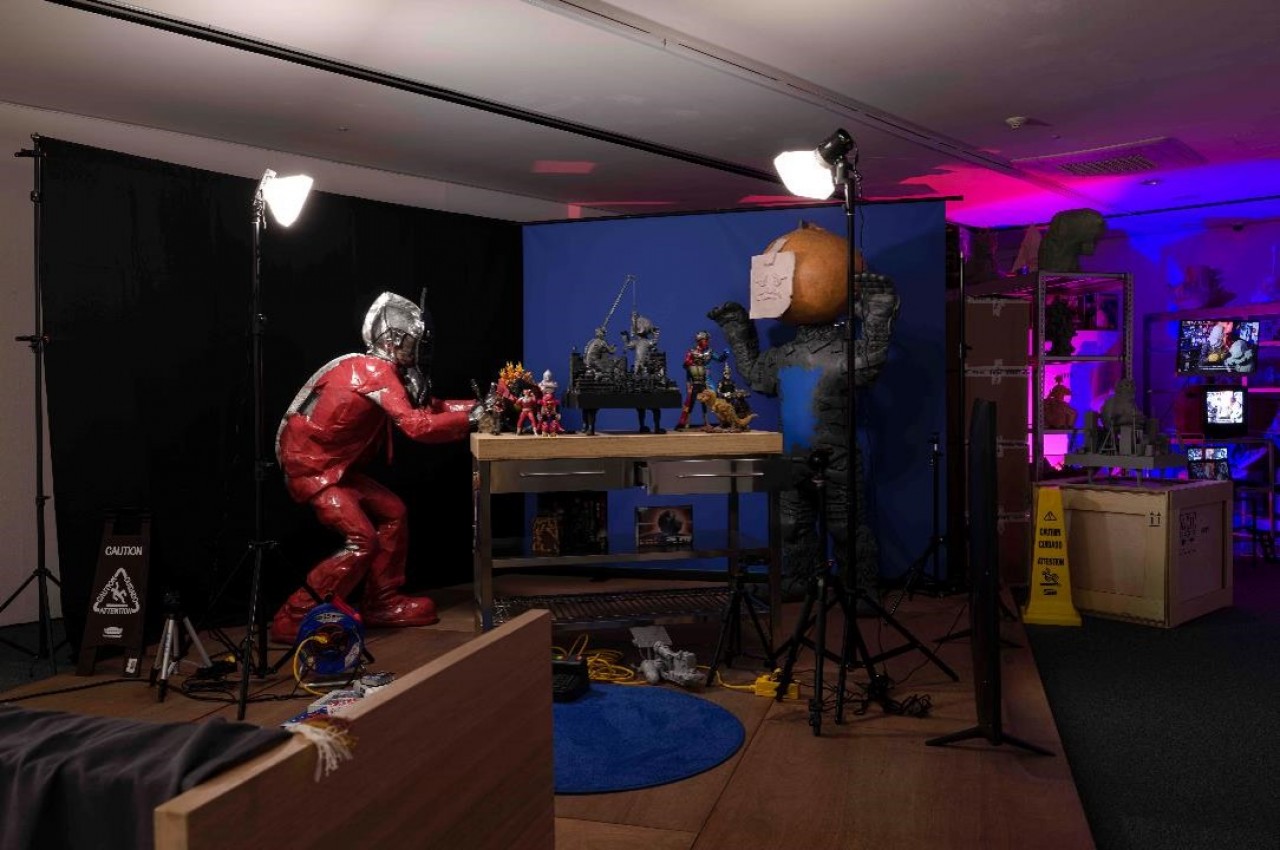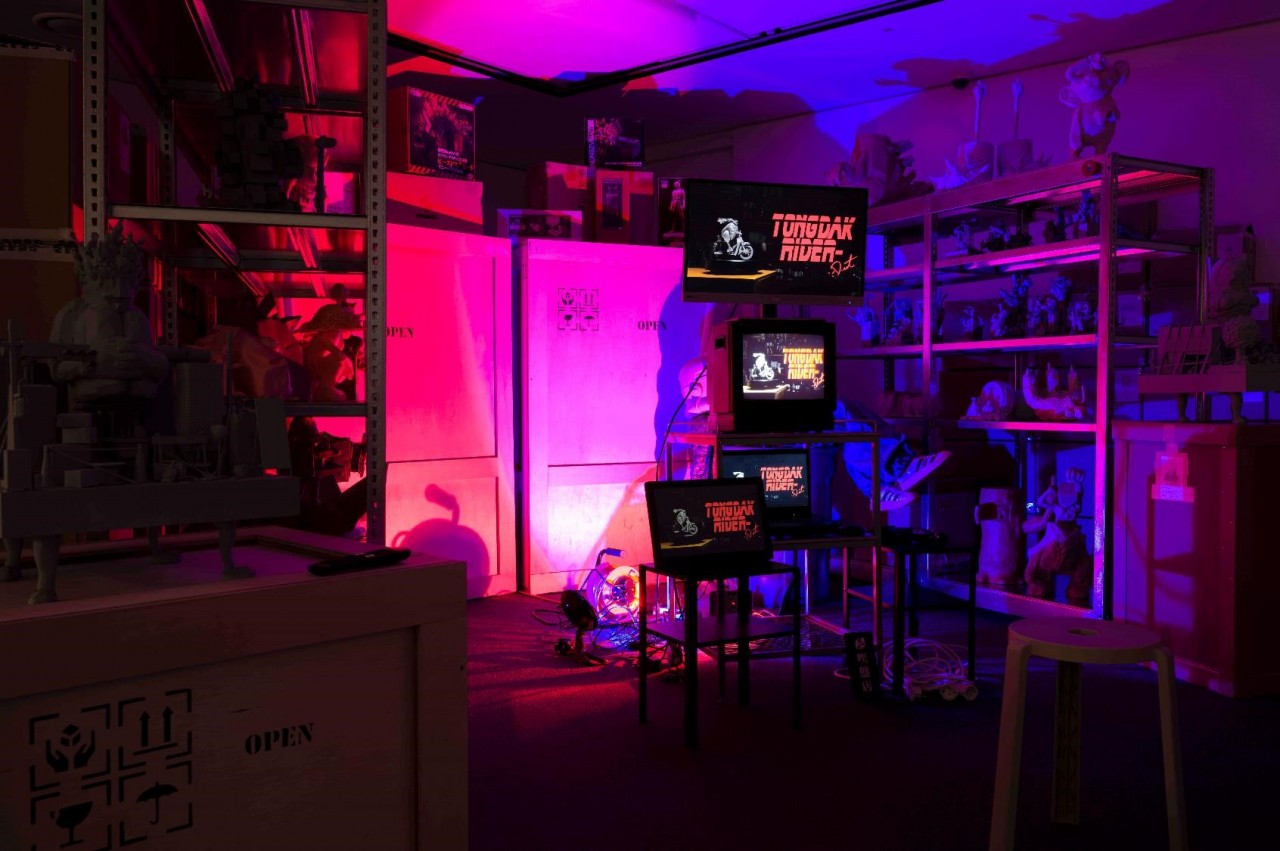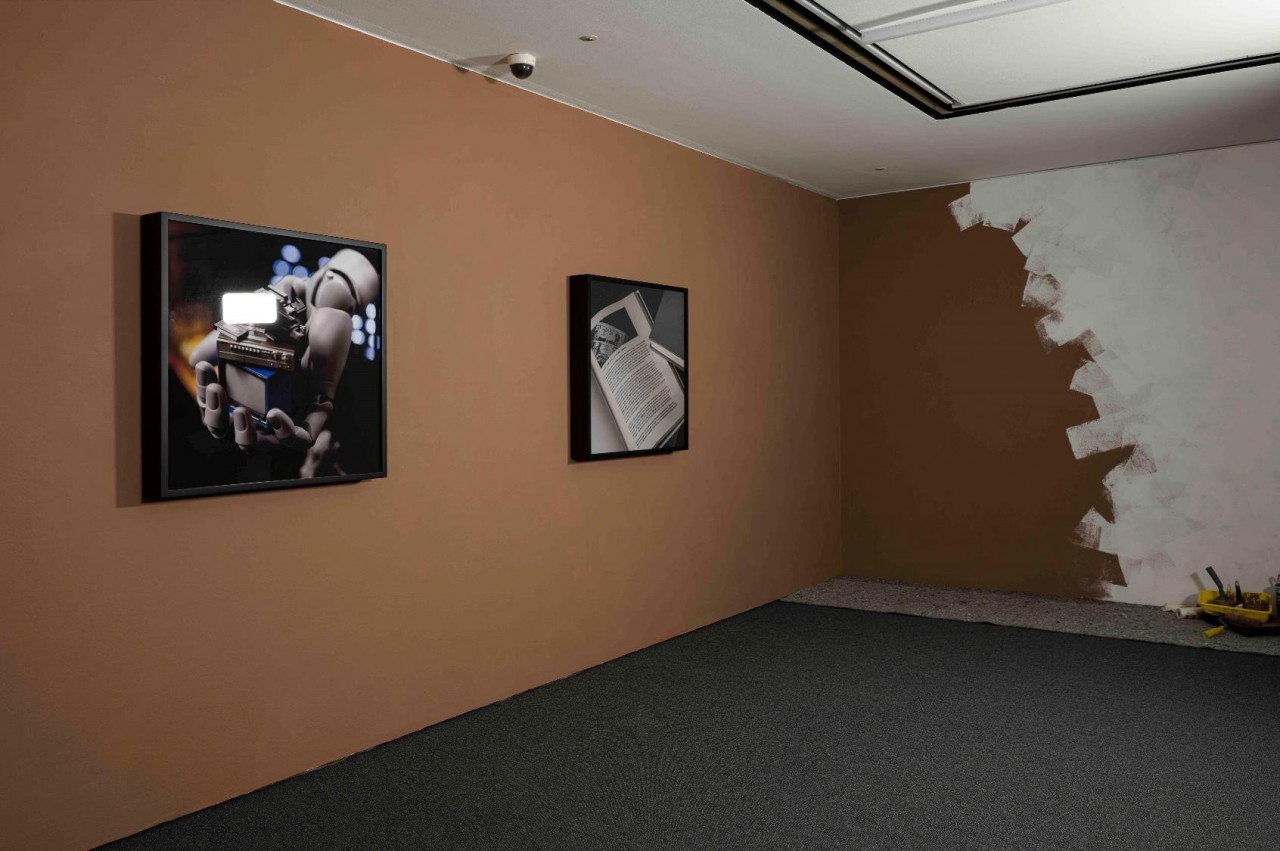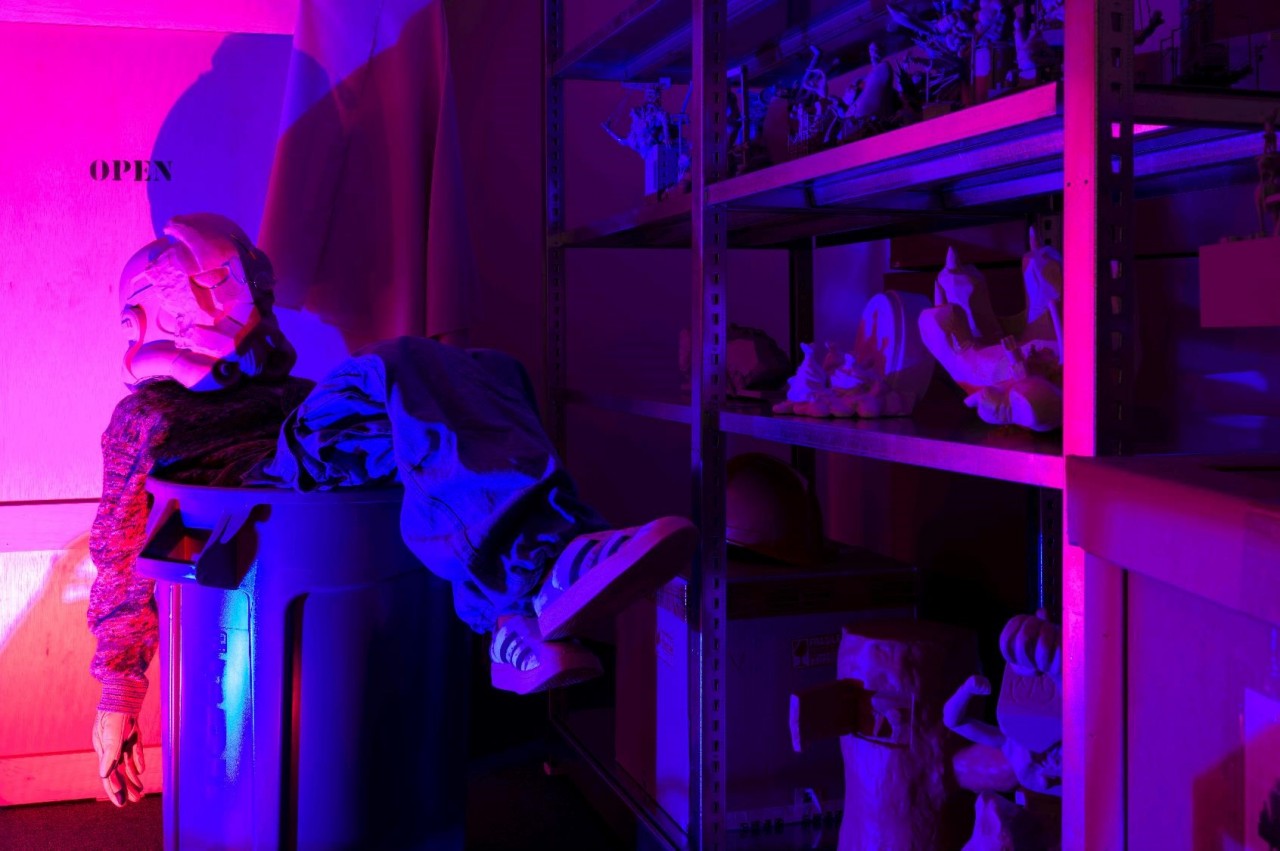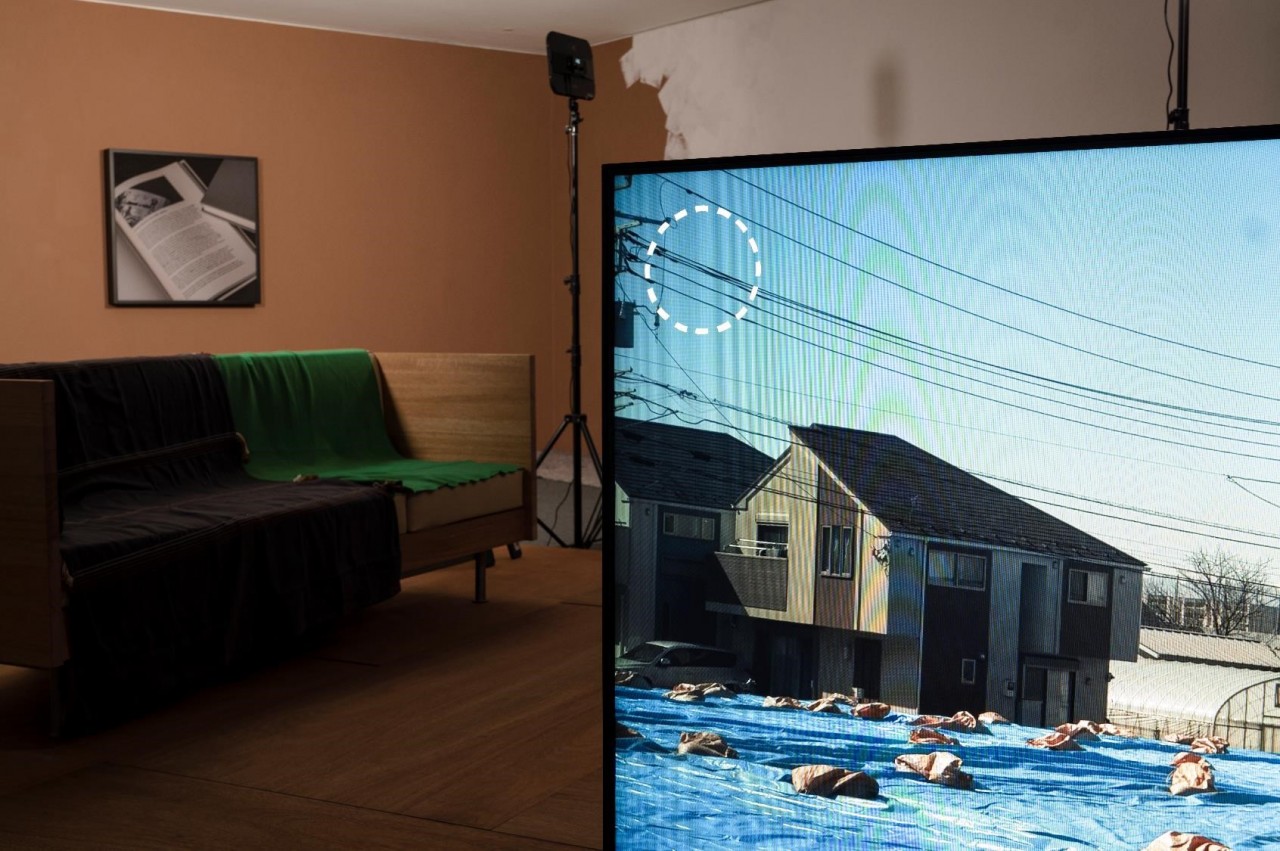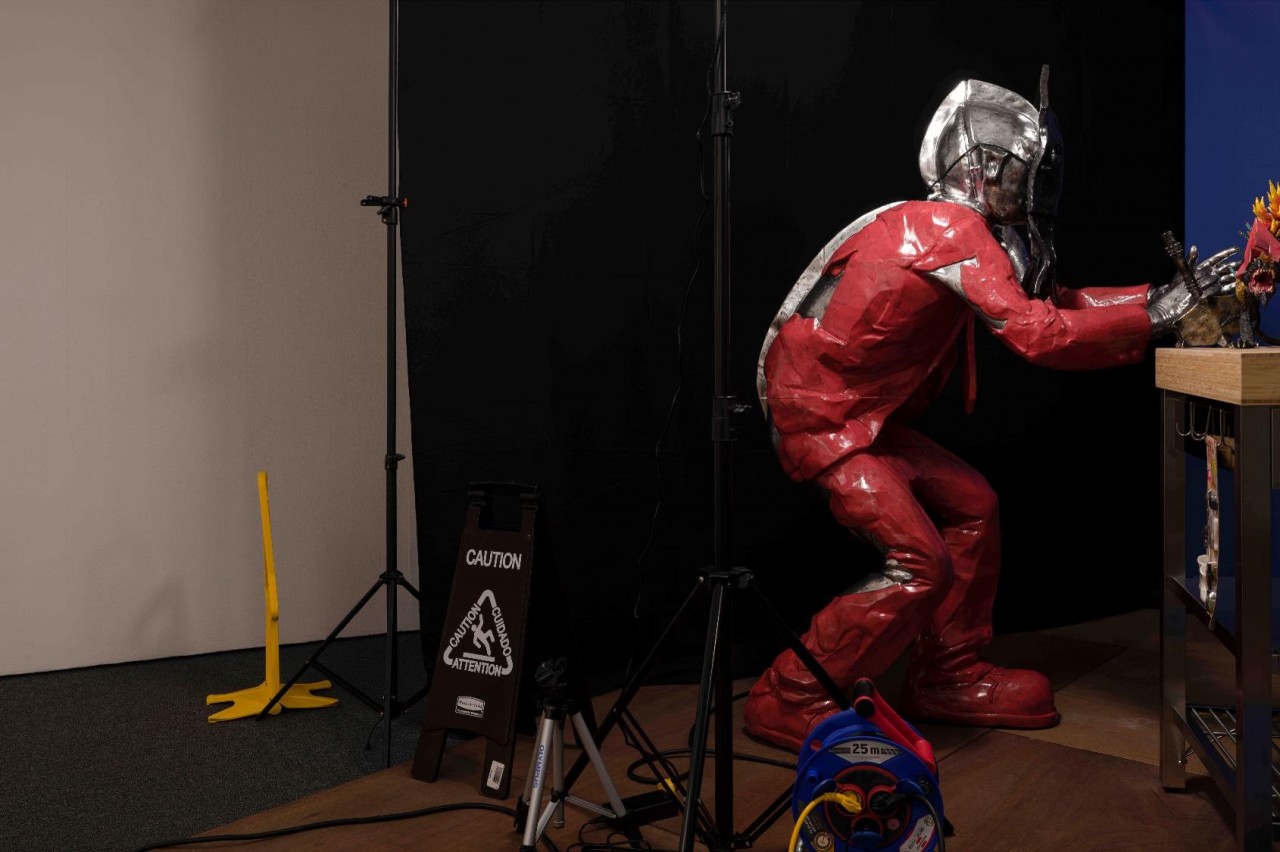Exhibitions
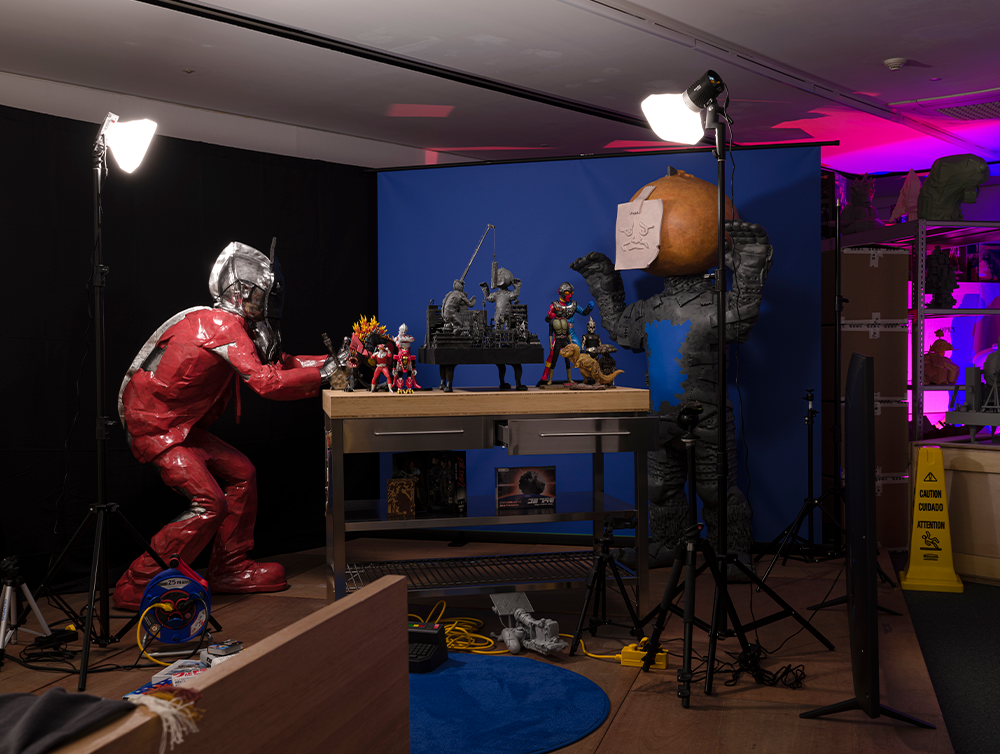
PERIGEE ARTIST #37 돈선필
음울한 귤
2025.05.30. FRI ~
2025.07.26. SAT
<무엇에 다가갈 것인가?>
신승오 (페리지갤러리 디렉터)
특촬(特撮)에 대한 관심에서 시작된 돈선필의 이번 전시는 《음울한 귤》이라는 독특한 이름을 가지게 되었다. 이는 우리말로 번역된 일본 만화에 등장하는 가상의 책 제목이다. 작가에 의하면 이것은 다른 소설 속 상상의 책 제목을 빌려서 언어유희로 만든 합성어로, 번역의 과정에서 이를 알아차리지 못한 번역가의 오역으로 나타났다. 이후 개정판에서는 이러한 내용을 각주로 달아 수정해 번역하긴 했지만, 이미 뭔가 어색한 단어는 존재하게 되었다. 작가는 이와 같은 번역의 오류를 흥미롭게 바라본다. 그렇다면 그것은 특촬과 함께 이번 전시에 어떻게 연결되는 것일까? 이번 글에서는 이를 최대한 따라가 보려 한다. 특촬은 아직 도래하지 않거나 이미 사라진 것 모두를 포함하여 상상을 기반한 가상의 시공간을 현실로 가져와 재현하기 위한 여러 가지 시도들이 결합하여 전개되어 나간다. 여기서 작가가 주목하는 지점은 영상으로 촬영된 이후 그것이 실체를 가진 존재들로 여전히 남아있다는 점이다. 가면, 슈트, 괴수의 몸체, 도심 공간을 표현한 디오라마 세트 등이 그렇다. 이들은 상황에 맞는 필요와 한계로 인해 어쩔 수 없는 조건들을 해결해 나가면서 만들어지고 촬영이 끝난 후에 남겨져 기묘한 형상들과 모양의 흔적을 고스란히 보여준다. 이처럼 우리는 무한히 상상하고 그것을 생생한 디지털 이미지로 실현하는 기술을 발전시키고 있지만, 다른 한....
"What Shall We Approach?"
Shin Seung Oh (Director, Perigee Gallery)
Don Sunpil's exhibition, which began with his interest in Tokusatsu (特撮), has been given the unique title Dreary Tangerine. This title comes from a fictional book that appears in a Japanese manga translated into Korean. According to Don, it is a compound word created as wordplay, borrowing the title of an imaginary book from another novel, which appeared as a mistranslation when the translator failed to recognize this. Although this was later corrected with a footnote in the revised edition, the awkward term had already come into existence. He finds such mistranslation intriguing. How, then, does this connect with Tokusatsu in this exhibition? This text will attempt to follow this thread as closely as possible. Tokusatsu unfolds through the combination of various attempts to bring imaginary space-time into reality, representing both what has not yet arrived and what has already faded away. What Don focuses on here is that after being filmed, these elements still remain as entities with physical presence. This includes masks, suits, mo....
신승오 (페리지갤러리 디렉터)
특촬(特撮)에 대한 관심에서 시작된 돈선필의 이번 전시는 《음울한 귤》이라는 독특한 이름을 가지게 되었다. 이는 우리말로 번역된 일본 만화에 등장하는 가상의 책 제목이다. 작가에 의하면 이것은 다른 소설 속 상상의 책 제목을 빌려서 언어유희로 만든 합성어로, 번역의 과정에서 이를 알아차리지 못한 번역가의 오역으로 나타났다. 이후 개정판에서는 이러한 내용을 각주로 달아 수정해 번역하긴 했지만, 이미 뭔가 어색한 단어는 존재하게 되었다. 작가는 이와 같은 번역의 오류를 흥미롭게 바라본다. 그렇다면 그것은 특촬과 함께 이번 전시에 어떻게 연결되는 것일까? 이번 글에서는 이를 최대한 따라가 보려 한다. 특촬은 아직 도래하지 않거나 이미 사라진 것 모두를 포함하여 상상을 기반한 가상의 시공간을 현실로 가져와 재현하기 위한 여러 가지 시도들이 결합하여 전개되어 나간다. 여기서 작가가 주목하는 지점은 영상으로 촬영된 이후 그것이 실체를 가진 존재들로 여전히 남아있다는 점이다. 가면, 슈트, 괴수의 몸체, 도심 공간을 표현한 디오라마 세트 등이 그렇다. 이들은 상황에 맞는 필요와 한계로 인해 어쩔 수 없는 조건들을 해결해 나가면서 만들어지고 촬영이 끝난 후에 남겨져 기묘한 형상들과 모양의 흔적을 고스란히 보여준다. 이처럼 우리는 무한히 상상하고 그것을 생생한 디지털 이미지로 실현하는 기술을 발전시키고 있지만, 다른 한편에서는 눈앞에 만질 수 있고 소유할 수 있는 물성을 가진 존재로 만들고자 하는 양가적 욕망을 품고 있다. 작가는 이런 과거의 유물 같은 특촬에서 실체에 대한 욕망을 재현하는 과정 그 자체와 이에 따라 자연스럽게 발생하는 재료와 기술의 문제, 그리고 경제적 수지 타산과 같은 요소가 혼재된 의도적, 우연적, 필연적 오류의 어긋남을 호기심 어린 태도로 파고들고 있다. 이는 위에서 언급한 번역의 오류에 대한 끌림과 유사하다.
일단 전시장의 구성에서 시작해 보자. 이번 전시는 끽태점(喫態店)이라 쓰여진 포렴(布簾)을 열고 들어가면 누군가의 특촬 작업실 혹은 수장고와 같이 꾸며진 공간에 지금까지 그가 수집하고, 제작하고, 쓴 여러 조각, 책, 영상, 글들이 놓여 있다. 예전 전시의 이름인 사물의 모습과 형태를 즐길 수 있는 상점을 의미하는 《끽태점》과 같은 요소를 사용하는 것으로 미루어 보면, 이번 전시는 그가 지금껏 해왔던 여정에서 나타난 것들의 총합을 통해 어떤 이야기를 전달하려 한다는 것을 어렵지 않게 추측해 볼 수 있다. 그러고 보니 돈선필이 지금까지 해왔던 작업은 본인의 삶과 동떨어지지 않은 밀착된 관심사에 기반하고 있었다. 그것은 그가 지속적으로 탐닉했던 망가와 아니메, 피규어 그리고 이번 전시의 특촬에 이르기까지 다양하다. 그리고 작가는 이를 단순히 보고 즐기는 취미에서 더 나아가 전문가의 영역에 다다르고 있다. 이러한 그가 쓴 글이나 만든 작품과 같은 활동을 유심히 살펴보면, 단순히 작가의 위치에 머무는 것이 아니라 그가 향유하고 있는 것을 관객에게 설명하고 이해시키기 위한 전달자 혹은 이들 문화가 가지고 있는 고유의 언어를 해석해서 들려주는 통역가 같은 느낌이 드는 것도 사실이다. 이번 도록에 실리게 될 특촬에 대한 꼼꼼한 소논문 같은 <특촬_ 재현을 위해 가공한 사물>이 이런 그의 태도를 잘 보여준다. 이는 아마도 그가 다루는 것이 가진 독특한 문화가 모두가 즐기는 대상은 아니기 때문일 것이다. 따라서 그의 작업은 모든 사람에게 동일하게 작동되는 것이 아닌 각자만의 거리를 유지하면서 이해하게 되는 차이를 의식하게 된다. 작가만큼의 근접한 위치에 있지 않다면, 그의 작업을 보는 나의 눈은 자기의 시각으로 보려 하지만, 어쩌면 작가의 관점을 흉내를 낼 뿐일 수도 있겠다. 그래서 그가 번역에 관해 이야기하듯 각자의 상황에 따라 이해의 정도가 다르며, 편견, 오해, 왜곡이 단계를 거칠수록 원본과는 전혀 다른 새로운 앎이 당연하게 시작된다. 하지만 이는 여전히 깊숙하게 파고들지 못하고 외부에 머무르며 아직 무엇이 되지 못한 상태일 것이다. 그렇기에 그의 지금까지의 작업은 그것이 가진 이야기들이 개인의 삶, 취미, 일에서 시작되어 모인 조각에서 글로, 영상으로, 다시 사물로 퍼져나가고 돌아오는 순환 구조로 촘촘하게 펼쳐져 있음이 확연히 드러나며, 우리가 이를 둘러볼 수 있는 환경을 만든다. 한편으로 그는 이와 같은 구조를 통해 그의 텍스트와 조형적 형태의 유격, 물성이 가진 외적인 변화와 표면이 균열하는 순간, 그리고 무엇인가 점점 다른 것들이 솟아오르는 과정을 어설프게 봉합하지 않는다. 오히려 정확하게 헤아릴 수 있는 거리를 유지하면서 그것에 대해 지속적인 관심을 보이며, 관찰하는 과정에서 발생해 새롭게 나타나는 것들에서 다시 출발하기를 반복한다. 이처럼 그의 작업은 다양한 이야기로 파생되어 여러 맥락으로 자연스럽게 확산하면서도 분절되지 않고 서로 이어지는 시공간이 바로 특촬이라 할 수 있겠다. 그렇기에 이것이 그의 작업이 원본, 정동, 시간, 언어 등 다양한 의미들을 발생시키고 담을 수 있는 틀이 되는 까닭이다.
그의 피규어에 대한 연구는 이런 특촬의 구조와 성격을 함축하고 있는 좋은 예가 된다. 그는 피규어가 가진 정확한 모습을 재현하는 것뿐만이 아니라 원본이 가진 현실적인 비율과 균형에서 벗어난 것들이 혼재된 모습을 여러 방식으로 분석해 나간다. 이는 누구에게는 아름답고 매력적이지만, 다른 이에게는 괴상하고 기묘한 새로운 혼합물로 읽힌다. 그리고 우리에게 피규어의 인체에서 유추할 수 있는 과장된 몸의 측면, 인체 기관의 기능들이 투명하게 드러나는 감상법이 아니라 실제의 것과 접점이 전혀 없는 모습들을 새로운 표면적 형태로 바라보게 만든다. 이처럼 작가는 특촬이라는 고요하면서도 걷잡을 수 없이 드러나는 호기심의 대상이 이끄는 대로 과장과 누락보다는 그가 인식하는 것들을 고스란히 펼쳐내는 작업의 방식을 보여준다. 이러한 방식은 내가 볼 수 있는 것을 보고, 내가 느낄 수 있는 것은 느끼게 하는 ‘나’의 내면과 연결해 아직은 알 수 없는 무엇인가를 표현하는 행위로 이루어진다. 이렇게 그가 이제껏 보여주었던 작업은 이것이 작동하는 과정에서 변형되어 어떤 실체를 가진 형태처럼 갑자기 나타난 구멍처럼 이상한 것이다. 그러나 그것은 수정하고 보완해야 하는 것이 아니라 그 틈을 따라가다 보면, 뭔가 놓치고 있었던 감춰진 새로운 곳으로 이동하게 만드는 통로로 보인다. 물론 이를 따라가는 것은 말처럼 쉬운 것이 아니다. 여기엔 많은 시간이 필요하다. 그가 시간성을 의식하는 것은 작업으로 나타난 것들이 경험이 쌓이는 축적된 시간을 통해 비로소 자신의 앞에 드러났기 때문일 것이다. 모든 것을 대하던 첫 순간을 떠올려보자. 처음에 찾아온 즉각적인 인상과 감각은 자극적이지만 무엇인가를 가리고 있는 느낌을 준다. 그러나 시간이 지나고 계속해서 바라보게 되면 갑자기 보이지 않았던 것이 발견되는 경우와 같이 처음의 인상과는 다른 차이를 느끼게 된 적이 있을 것이다. 작가는 이런 차이가 서서히 어떤 형태로 드러나는 지점을 새로운 것이 등장하는 시작점으로 인식하고 있다.
여기서 전시의 출발점인 번역으로 돌아와 보자. 그에게 이상한 번역은 색다른 표현으로 보이지만, 사실 불충실한 정보이다. 하지만 내용이 가진 사실에 충실한 번역이라 해도 완벽할 수 없는 실패한 번역이 된다. 따라서 그는 그 편차가 가져오는 마찰을 성공과 실패를 가르는 잣대가 아니라 무엇인가 새로운 것이 발생할 가능성을 내재한 토대로 바라본다. 이를 수용하기 위해서 그 어느 때보다 필요한 것은 정신의 유연성과 함께 무엇인가를 새롭게 시작할 용기, 아니 오히려 그 실패를 반복해서 수행하고 수용할 수 있는 성실성일지도 모르겠다. 이는 이번 전시에 선보이는 <Re-Reset>영상에서 찾아볼 수 있다. 계속해서 리셋을 누르는 것은 무엇인가를 반복하는 순환 같지만 하나도 같을 수 없는 온전히 새로운 시작인 재설정을 동시에 의미한다. 이와 같이 그의 작업은 일상처럼 소리 없이 움직이는 다층적 변화와 그 사이를 조용히 파고들고 있으며, 그 균열의 형태와 현상을 관찰함으로써 반복적으로 재설정하는 중이다. 그가 이번 전시에 관심을 가진 특촬 역시 이와 같은 가상과 실재의 표면이 분리되지 않는 이상한 양가적인 시공간을 계속해서 열어 보인다. 이들의 역사가 진행되는 동안 지속적으로 구축되어 나간 시간의 축적은 흔적들로 남아 그만큼의 모양과 형태를 보여준다. 이에 대해 작가는 이전 작업에서 ‘열화’라는 표현을 쓰고 있는데, 어떤 상황이 벌어지고 난 결과물을 달리 보면 그것은 어디에서 고정된 것이 아니라 미끄러져 무너지는 그 순간의 결과물이라 볼 수도 있겠다. 이것이 그가 말하는 번역의 오류, 온전히 그 의미를 담을 수 없고 옮길 수 없는 한계를 의미하기보다는 그러한 기묘한 상황에서 비로소 드러나는 것들의 신선함일 것이다. 그렇지만 전시에서 누군가에게 어떤 자극, 흥분, 충동은 전혀 일어나지 않기도 하고 확실하게 일어나기도 한다. 따라서 그가 의도적으로 인과적인 선형적 구성이 아닌 과거의 것에서부터 지금의 것까지, 또한 전시장이면서 끽태점인 동시에 특촬의 작업실 혹은 수장고와 같이 느껴지는 병렬적 방식의 구성은 여러 연상 작용이 한꺼번에 제시되어 관객들의 관심에 따라 서로 다른 접근이 가능한 시공간을 만들기 위함일 것이다.
이처럼 돈선필의 전시는 하나의 원형으로부터 새롭게 나타나 어딘가로 이어지는 여러 갈래의 길이 펼쳐진 모습으로 나타난다. 그렇지만 그것은 작가의 완결된 판단과 같은 확정적 작업으로 나타나지 않는다. 단지 어떤 분위기를 통해 일시적으로 일어나는 감정들, 무엇인가를 가로지른 이후에야 도달할 수 있는 가상과 실재 사이에 존재하는 보이지 않는 길을 드러나게 만든다. 따라서 작가가 제시하는 것은 온전한 하나로 귀결된 이야기가 아니라 여러 갈래로 퍼져나가는 이야기의 출발점이 되어 비로소 실체를 가지게 된 존재이다. 그가 이미 선보였던 기존의 조각, 영상, 글을 다시 지금 이 자리에 소환하는 것은 이를 다시 돌아보기 위해서이다. 그렇게 그들은 작가와 함께 만들어졌고 우리의 눈을 자극하기를 반복하며, 다시 지금 나타나 우리를 재설정한다. 지금까지 살펴본 것과 같이 그가 해왔던 전시, 작품, 기획, 글, 수집과 같은 여러 행위는 처음에 언급했던 것처럼 자기 자신이 좋아하고 향유하고 있는 것들을 타인에게 알려주어 호기심을 유발하는 시작점의 일환이라는 생각이 든다. 결국 《음울한 귤》 전시에서 우리는 각자 어느 것에 다가갈 것인지 알 수 없다. 다만 우리는 여러 지점 중에 무엇인가를 선택하게 될 것이고 그 뒤에 찾아오는 오차, 오류 그리고 어쩔 수 없는 오해를 불가항력적이며, 당연한 절차로 받아들여야 할 것이다. 그런 이후에 그것이 무엇이든지 우리는 새롭게 다시 또 움직이기 시작할 토대를 자연스럽게 마련하게 된다. 그리고 이런 과정을 반복하고 재설정하는 것이야말로 서로 다른 것들이 다층적으로 쌓여가는 시공간에서 우리가 무엇인가를 새롭게 만들어 낼 가능성을 여는 길인 것이다. 그러고 보니 작가와 처음 만난 날에 이야기를 나누다 작가의 이름이 활동명인지 본명인지 물어본 것이 생각난다. 필자에게는 아무것도 아닌 이 사소한 질문의 순간이 이미 그의 작업에서 호기심 어린 시선을 던지며 새로운 길로 갈라지기 시작한 분기점인 것 같다. 사실 그에게 전시를 제안했을 때부터 글을 쓰고 있는 지금까지 작가의 작업에 밀착되기보다 조금씩 다른 길로 가고 있기를 은근히 바라고 있었는지도 모르겠다. 이제는 글을 다 읽은 그대들의 차례이다. 이 전시에서 그대들은 무엇에 다가갈 것인가?
Shin Seung Oh (Director, Perigee Gallery)
Don Sunpil's exhibition, which began with his interest in Tokusatsu (特撮), has been given the unique title Dreary Tangerine. This title comes from a fictional book that appears in a Japanese manga translated into Korean. According to Don, it is a compound word created as wordplay, borrowing the title of an imaginary book from another novel, which appeared as a mistranslation when the translator failed to recognize this. Although this was later corrected with a footnote in the revised edition, the awkward term had already come into existence. He finds such mistranslation intriguing. How, then, does this connect with Tokusatsu in this exhibition? This text will attempt to follow this thread as closely as possible. Tokusatsu unfolds through the combination of various attempts to bring imaginary space-time into reality, representing both what has not yet arrived and what has already faded away. What Don focuses on here is that after being filmed, these elements still remain as entities with physical presence. This includes masks, suits, monster bodies, and diorama sets expressing urban spaces. These are created while resolving inevitable conditions due to situational needs and limitations, and after filming, they remain to reveal traces of their peculiar forms and shapes. Thus, while we are developing technology to realize our infinite imagination into vivid digital images, we simultaneously harbor a dual-natured desire to create them as tangible entities that can be touched and possessed. Don explores these Tokusatsu artifacts of the past with a curious attitude, delving into the process of representing the desire for substance itself and the misalignments of intentional, accidental, and inevitable errors that naturally arise from the mixture of material and technical issues, as well as economic cost-benefit calculations. This is similar to his attraction to mistranslations mentioned above.
Let's start with the exhibition layout. Upon entering through a noren (布簾) inscribed with "Kitsutaiten" (喫態店), the space is arranged like someone's Tokusatsu workshop or storage room, containing various sculptures, books, videos, and texts that he has collected, produced, and written until now. Considering his use of elements from his previous exhibition titled Kitsutaiten, which means a shop where one can enjoy the appearance and form of objects, it's not difficult to guess that this exhibition aims to convey a story through the sum of what has emerged from his journey thus far. Looking back, Don Sunpil's work has always been based on interests closely tied to his personal life. These range from manga and anime to figures, and now to Tokusatsu in this exhibition. Don has progressed beyond merely observing and enjoying these as hobbies and is reaching the level of an expert. When closely examining his activities, such as his writings and created works, it becomes apparent that he is not merely remaining in the position of an artist but rather takes on the role of a messenger explaining and helping audiences understand what he enjoys, or an interpreter translating and conveying the unique language these cultures possess. His meticulous work resembling a scholarly article, Tokusatsu_Objects Processed for Representation, which will be included in this exhibition catalog, well demonstrates this attitude. This is probably because the unique culture he deals with is not something everyone enjoys. Therefore, his work does not function identically for everyone, but rather makes one conscious of the differences in understanding that emerge as each person maintains their own distance. Unless one is in as close a position as the artist, my eyes trying to view his work through my own perspective might merely be imitating the artist's viewpoint. Thus, as he discusses translation, the degree of understanding varies according to each person's situation, and as prejudice, misunderstanding, and distortion pass through stages, entirely new knowledge naturally begins to emerge, different from the original. However, this still remains on the exterior, unable to delve deeply, in a state that has not yet become something. Therefore, his work thus far clearly reveals a tightly woven circular structure where stories originating from personal life, hobbies, and work spread from fragments to text, to video, and back to objects, creating an environment where we can observe this process. On the other hand, through such a structure, he does not clumsily try to patch up the gaps between his texts and sculptural forms, the moments when materiality's external changes and surfaces crack, and the process of different things gradually emerging. Rather, while maintaining an accurately measurable distance, he shows continuous interest and repeatedly starts anew from things that appear during the observation process. In this way, his work could be said to be Tokusatsu itself – a space-time that naturally expands into various contexts while deriving into diverse stories, yet remains connected without segmentation. This is why it becomes a framework that can generate and contain various meanings such as originals, affect, time, and language.
His research on figures serves as a good example embodying such structure and characteristics of Tokusatsu. He analyzes in various ways not only the accurate representation of figures but also their mixed appearance that deviates from the original's realistic proportions and balance. While beautiful and attractive to some, to others this reads as a new hybrid that is strange and bizarre. Rather than a method of appreciation that reveals the exaggerated aspects of the body and the transparent functions of bodily organs that can be inferred from the human form of figures, he makes us view appearances that have no connection whatsoever with actual things as new surface forms. Thus, Don demonstrates a working method that fully unfolds what he perceives, led by Tokusatsu as an object of curiosity that is both quiet and uncontrollable, rather than exaggeration and omission. This method consists of actions expressing something yet unknown, connected to one's inner self that sees what I can see and feels what I can feel. The work he has shown thus far is strange like a hole that suddenly appears as a form with substance, transformed in the process of its operation. However, this is not something to be corrected or supplemented; rather, it appears as a passage that, when followed along its gaps, leads to a new hidden place that was somehow missed. Of course, following this is not as easy as it sounds. It requires much time. His consciousness of temporality likely stems from the fact that his works appeared before him only through accumulated time of building experience. Let's recall the first moment of encountering everything. The immediate impression and sensation that comes at first is stimulating but gives a feeling of concealing something. However, as time passes and we continue to look, we might have experienced feeling a difference from the initial impression, like suddenly discovering something that wasn't visible before. Don recognizes such points where differences gradually reveal themselves in some form as starting points for the emergence of something new.
Let's return to translation, the starting point of the exhibition. To him, peculiar translations appear as novel expressions but are, in fact, unfaithful information. However, even translations faithful to the facts contained in the content cannot be perfect and become failed translations. Therefore, he views the friction brought by this variance not as a measure of success and failure, but as a foundation inherently possessing the possibility for something new to emerge. What is needed more than ever to accept this might be mental flexibility along with the courage to start something new, or rather, the sincerity to repeatedly perform and accept that failure. This can be found in the video work Re-Reset presented in this exhibition. Continuously pressing “Reset” simultaneously means a cycle of repetition where nothing can be the same and a completely new start of reconfiguration. Similarly, his work quietly penetrates between multilayered changes that move silently like daily life, and is in the process of repeatedly reconfiguring by observing the forms and phenomena of those cracks. The Tokusatsu he has taken an interest in for this exhibition also continues to open and reveal such strange ambivalent space-time where real and virtual surfaces are not separated. The accumulation of time, continuously built throughout their history, remains as traces showing that much shape and form. Regarding this, Don uses the expression “deterioration” in his previous work, and if we view the result of what has occurred differently, it could be seen as the result of that moment of sliding and collapsing rather than being fixed somewhere. This would be the freshness of things that finally emerge in such bizarre situations, rather than meaning the limitations of translation errors, the inability to fully contain and transfer meaning. However, in the exhibition, some people may experience no stimulation, excitement, or impulse at all, while others definitely do. Therefore, his intentional parallel composition – from past works to current ones, feeling simultaneously like an exhibition space, Kitsutaiten, and Tokusatsu workshop or storage – rather than a causal linear composition, is likely intended to create a space-time where different approaches are possible according to viewers' interests as various associative effects are presented all at once.
Thus, Don Sunpil's exhibition appears as multiple paths spreading from one archetype and leading somewhere new. However, this does not appear as definitive work like Don’s complete judgment. It only reveals an invisible path existing between virtual and real, which can only be reached after crossing something through temporary emotions arising through certain atmospheres. Therefore, what Don presents is not a story culminating in one complete whole, but an entity that finally gains substance by becoming the starting point of stories spreading in various directions. His summoning of existing sculptures, videos, and texts that he has already shown to this present place is to look back at them again. Thus, they were created together with him and repeatedly stimulate our eyes, appearing again now to reconfigure us. As we have examined, his various actions such as exhibitions, works, projects, writings, and collections seem to be part of starting points that evoke curiosity by sharing with others what he likes and enjoys, as mentioned at the beginning. Ultimately, in the exhibition Dreary Tangerine, we don't know what each of us will approach. We will choose something among various points, and must accept the subsequent deviation, error, and inevitable misunderstanding as an unavoidable and natural process. After that, whatever it might be, we naturally establish a foundation to begin moving forward anew. And repeating and reconfiguring this process is the path that opens the possibility for us to create something new in a space-time where different things accumulate in multiple layers. Come to think of it, I remember asking whether his name was the artist name or real name when I first met him. To me, this trivial question moment seems to have already become a branching point where curious gazes begin to split into new paths in his work. In fact, from when I proposed the exhibition until now as I write this essay, I might have secretly hoped to be going on slightly different paths rather than adhering closely to Don’s work. Now it's your turn, those who have finished reading this. In this exhibition, what shall we approach?



